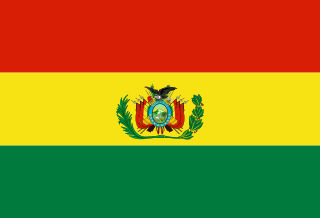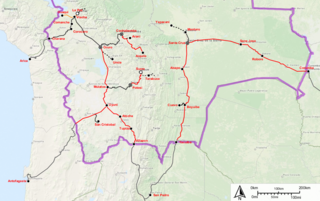
The Bolivian Armed Forces are the military of Bolivia. The Armed Forces of Bolivia are responsible for the defence, both of external and internal, of Bolivia and they are constituted by Bolivian Army, the Bolivian Air Force and the Bolivian Navy. All these institutions depend on the Ministry of Defence of this country.

Lloyd Aéreo Boliviano S.A.M., was the flag carrier and principal airline of Bolivia from 1925 until it ceased operations in 2010. Before its demise it was headquartered in Cochabamba and had its main hubs at Jorge Wilstermann International Airport and Viru Viru International Airport. Founded in September 1925, it was the second oldest airline in South America after Avianca and one of the oldest airlines in the world.

The Trans-Andean railways provide rail transport over the Andes. Several are either planned, built, defunct, or waiting to be restored. They are listed here in order from north to south.

The Bolivian Navy is a branch of the Armed Forces of Bolivia. As of 2008, the Bolivian Navy had approximately 5,000 personnel. Although Bolivia has been landlocked since the War of the Pacific and the Treaty of Peace and Friendship (1904), Bolivia established a River and Lake Force in January 1963 under the Ministry of National Defense. It consisted of four boats supplied from the United States and 1,800 personnel recruited largely from the Bolivian Army. The Bolivian Navy was renamed the Bolivian Naval Force in January 1966, but it has since been called the Bolivian Navy as well. It became a separate branch of the armed forces in 1963. Bolivia has large rivers which are tributaries to the Amazon which are patrolled to prevent smuggling and drug trafficking. Bolivia also maintains a naval presence on Lake Titicaca, the highest navigable lake in the world, which the country shares with Peru.

Municipalities in Bolivia are administrative divisions of the entire national territory governed by local elections. Municipalities are the third level of administrative divisions, below departments and provinces. Some of the provinces consist of only one municipality. In these cases the municipalities are identical to the provinces they belong to. There are 340 municipalities.

The following outline is provided as an overview of and topical guide to Bolivia:
Following is a list of railway stations in Bolivia, categorized by eastern and western networks. The eastern and western networks do not directly connect, except via a roundabout route through Argentina.

The Bolivian rail network has had a peculiar development throughout its history.

Aero Comercial Oriente Norte Ltda., doing business as Aerocon, was a Bolivian airline. Its national office was in Hangar 93 in El Trompillo Airport in Santa Cruz de la Sierra.

The invasion of the Iberian Peninsula in 1807-08 by Napoleon Bonaparte's forces proved to be critical for the independence struggle in South America, during which the local elites of Upper Peru remained mostly loyal to Spain, supporting Junta Central, a government which ruled in the name of the overthrown king Ferdinand VII of Spain. A number of radical criollos in 1808-10 began a local power struggle. Pedro Domingo Murillo proclaimed an independent state in Upper Peru in the name of king Ferdinand VII. During the following seven years Upper Peru became the battleground between the armed forces of independent United Provinces of the Río de la Plata and royalist troops from Viceroyalty of Peru.
Toledo (Oruro) is a small town in Bolivia. Toledo is the administrative seat of Saucarí Province, as well as that of Toledo Municipality. The town lies at an elevation of 3,715 metres (12,188 ft) between Río Laq'a Jawira in the west and Río Vinto Jahuira in the east, both of which drain into Lake Poopó.

The 2010 Bolivian regional elections were held on 4 April 2010. Departmental and municipal authorities were elected by an electorate of approximately 5 million people. Among the officials elected are:

Xavier Moyano is an Argentine musician; producer, performer, composer, and educator. He began his career as a session guitarist in Tucuman in 1999. By 2003 was the guitarist for rock/pop band "AVe Cesar" until 2008, after that he became a solo rock instrumentalist. Between 2009 and 2011 he was guitarist and composer of metal band "Seliger" (Argentina/Brasil), between 2014 and 2019 he was guitarist and producer of "Cossas Novas", since 2018 he is guitarist and co-producer of "Rock Bro's" (ClassicRock). He is currently a solo guitarist, session musician and producer.

Bolivians are people identified with the country of Bolivia. This connection may be residential, legal, historical or cultural. For most Bolivians, several of these connections exist and are collectively the source of their being Bolivian.
The South American Youth Championship 1995 was held in Cochabamba, La Paz and Santa Cruz, Bolivia. It also served as qualification for the 1995 FIFA World Youth Championship.
A pukara is a pre-Hispanic central Andean fortress.

The history of rail transport in Bolivia began in the 1870s after almost three decades of failed efforts to build railroads to integrate the country, mining was the driving force for the construction of railways. The need to transport saltpeter to the coast triggered the first railway lines in Bolivia. It was the silver mining, however, that drove the construction of a railway from the Pacific coast to the high plateau during the nineteenth century. Later, at the beginning of the twentieth century, tin mining gave a new impetus to railway building, forming what is now known as the Andean or Western network. The eastern network, on the other hand, developed between the years 1940 and 1960 and is financed in exchange for oil through agreements with Argentina and Brazil. Bolivia being a landlocked country, the railways played a fundamental role and the history of its railroads is the history of the country's efforts to reach first ports on the Pacific coast and then the Atlantic.
Route 4 is a National Road in Bolivia. It is 1,657 kilometres in length, and crosses Bolivia from west to east, from the Cordillera Occidental on the Chilean border to the lowlands by the Brazilian border.














